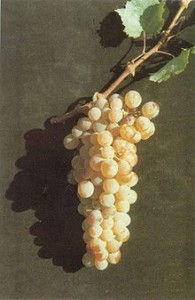Calling Greece
When Greece held the Summer Olympics in 2004, you couldn’t open a wine or lifestyle glossy without coming across an article on Greek wine. Since the mid-aughts, the indigenous varieties of Greece have been resurrected and new trends have emerged. We spoke to a few industry insiders to explore these popular, award-winning wines.
If you simply take a look at New York City, and bear in mind that Assyrtiko is a relatively obscure grape, the wines from the volcanic island of Santorini are on fire right now. Anfora and John Dory Oyster Bar offer the Sigalas Assyrtiko on their lists, and one of the top selling wines by the glass at Boulud Sud is from Santorini. Meanwhile, during the month of April, Molyvos wine director, Kamal Kouiri, will pour a lofty fifteen wines by the glass from this particular Aegean Island (in conjunction with Taste Santorini - a series of trade and consumer events focusing on the island’s wines). He tells us, “When young these wines taste of the sea, minerals and brine -- and the acidity is fantastic.”
The pink-skinned Moschofilero grape is getting a nice little spotlight at John Dory Oyster Bar. “We pour the Anassa Moschofilero by the glass, from the keg. I think it's a fantastic wine. Aromatic, crisp and easy going, just what kegs should be,” enthuses the wine director, Carla Rzeszewski. And, if you haven’t heard of it yet, the lesser-known aromatic and fuller-bodied Malagousia is slated to become a grape to gain affection.
For red wine grapes, favorites are Xinomavro, followed by Agiorgitiko. On the former Kouiri supports, “Xinomavro, especially from Naoussa in Macedonia, is a wine lovers’ grape. It makes a dry, deep colored wine with complex aromas, high acid and big tannins. You could easily age these wines for 15 to 20 years.” Into the realms of experimentation, Sofia Perpera has seen intriguing examples of dry Mavrodaphne wines, a grape typically reserved for the sweet Mavrodaphne of Patras.
The sweet wines from the island of Samos are some of the best-known Greek dessert wines, along with the fortified, port-like Mavrodaphne of Patras. One particular producer that’s not hard to find in wine shops across the country is Kourtaki, a large company also known for their Retsina. Kourtaki produces both a Muscat Blanc a Petits Grains and a Mavrodaphne of Patras, which won gold in the 2012 NY International Wine Competition.
boulxiBut the geek dessert wine of Greece takes us back to Santorini where they make Vinsanto (not to be confused with the Italian Vin Santo). Made from the local Assyrtiko, Aidani and Athiri varieties, grapes are picked extremely ripe and left to dry in the passito method, after fermentation the wine is aged in barrel. Vinsanto shows astonishing earthy, honeyed, nutty character and develops complexity with age. Molyvos carries a range of different vintages dating back to 1983. Kouiri currently pours a 1989 by the glass, produced by Argyros Estate.
Greek grapes are old heirlooms, and the land is certainly ancient, but what’s really new is the current generation of winemakers. “What excites me are the young winemakers. Their fathers were growing grapes to sell to large companies and now their sons and daughters are going to wine schools abroad and seeing different styles of winemaking all over the world,” says Kouiri. Pointing us in the direction of the up-and-coming he mentions Nikos Karatzas of Ktima Pavlidisin Drama (a northern region in Greece), Apostolos Thimiopoulos of Thimiopoulos Vineyards in Naoussa, Matthew Argyros of Ktima Agyros in Santorini, Angelos Iatridis of Alpha Estate in Amyndeon (Macedonia) and Kostis Dalamaras of Dalamara Winery in Naoussa.”


